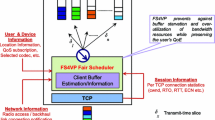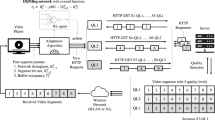Abstract
The coexistence of parallel applications in shared computing nodes, each one featuring different Quality of Service (QoS) requirements, carries out new challenges to improve resource occupation while keeping acceptable rates in terms of QoS. As more application-specific and system-wide metrics are included as QoS dimensions, or under situations in which resource-usage limits are strict, building and serving the most appropriate set of actions (application control knobs and system resource assignment) to concurrent applications in an automatic and optimal fashion become mandatory. In this paper, we propose strategies to build and serve this type of knowledge to concurrent applications by leveraging Reinforcement Learning techniques. Taking multi-user video transcoding as a driving example, our experimental results reveal an excellent adaptation of resource and knob management to heterogeneous QoS requests, and increases in the amount of concurrently served users up to 1.24 × compared with alternative approaches considering homogeneous QoS requests.





Similar content being viewed by others
References
Bossen F, Common H (2013) Test conditions and software reference configurations. JCT-VC Doc
Costero L, Iranfar A, Zapater M, Igual FD, Olcoz K, Atienza D (2019) MAMUT: multi-agent reinforcement learning for efficient real-time multi-user video transcoding. In: Design, Automation Test in Europe Conference
Farhad SM, Bappi MSI, Ghosh A (2016) Dynamic resource provisioning for video transcoding in IaaS cloud. In: 2016 IEEE 18th International Conference on High Performance Computing and Communications, IEEE, pp 380–384
Gao G, Wen Y, Westphal C (2016) Dynamic resource provisioning with QoS guarantee for video transcoding in online video sharing service. In: 2016 ACM Multimedia Conferecne—MM ’16, pp 868–877
Gao G, Wen Y, Westphal C (2019) Dynamic priority-based resource provisioning for video transcoding with heterogeneous QoS. IEEE Trans Circuits Syst Video Technol 29(5):1515–1529
Ho HN, Lee E (2015) Model-based reinforcement learning approach for planning in self-adaptive software system. In: International Conference on Ubiquitous Information Management and Communication, pp 103:1–103:8
IBM (2005) An architectural blueprint for autonomic computing. Technical Report, IBM
Iranfar A, Zapater M, Atienza D (2018) Machine learning-based quality-aware power and thermal management of multistream HEVC encoding on multicore servers. IEEE Trans Parallel Distrib Syst 29(10):2268–2281
Sembiring K, Beyer A (2013) Dynamic resource allocation for cloud-based media processing. In: ACM Workshop on Network and Operating Systems Support for Digital Audio and Video. ACM Press, pp 49–54
Singh S, Chana I (2015) QoS-aware autonomic resource management in cloud computing. ACM Comput Surv 48(3):1–46
Sullivan GJ, Ohm JR, Han WJ, Wiegand T (2012) Overview of the high efficiency video coding (HEVC) standard. IEEE Trans Circuits Syst Video Technol 22(12):1649–1668
Sutton RS, Barto AG (1998) Reinforcement learning: an introduction, vol 1. MIT Press, Cambridge
Viitanen M, Koivula A, Lemmetti A, Ylä-Outinen A, Vanne J, Hämäläinen TD (2016) Kvazaar: open-source HEVC/H.265 encoder. In: 24th ACM International Conference on Multimedia
Wang L, Gelenbe E (2018) Adaptive dispatching of tasks in the cloud. IEEE Trans Cloud Comput 6(1):33–45
Funding
This work has been partially supported by the EU (FEDER), the Spanish MINECO and the CM under Grants S2018/TCS-4423, TIN 2015-65277-R and RTI2018-093684-B-I00 and the Spanish MECD under Grant FPU15/02050.
Author information
Authors and Affiliations
Corresponding author
Additional information
Publisher's Note
Springer Nature remains neutral with regard to jurisdictional claims in published maps and institutional affiliations.
Rights and permissions
About this article
Cite this article
Costero, L., Igual, F.D., Olcoz, K. et al. Leveraging knowledge-as-a-service (KaaS) for QoS-aware resource management in multi-user video transcoding. J Supercomput 76, 9388–9403 (2020). https://doi.org/10.1007/s11227-019-03117-9
Published:
Issue Date:
DOI: https://doi.org/10.1007/s11227-019-03117-9





